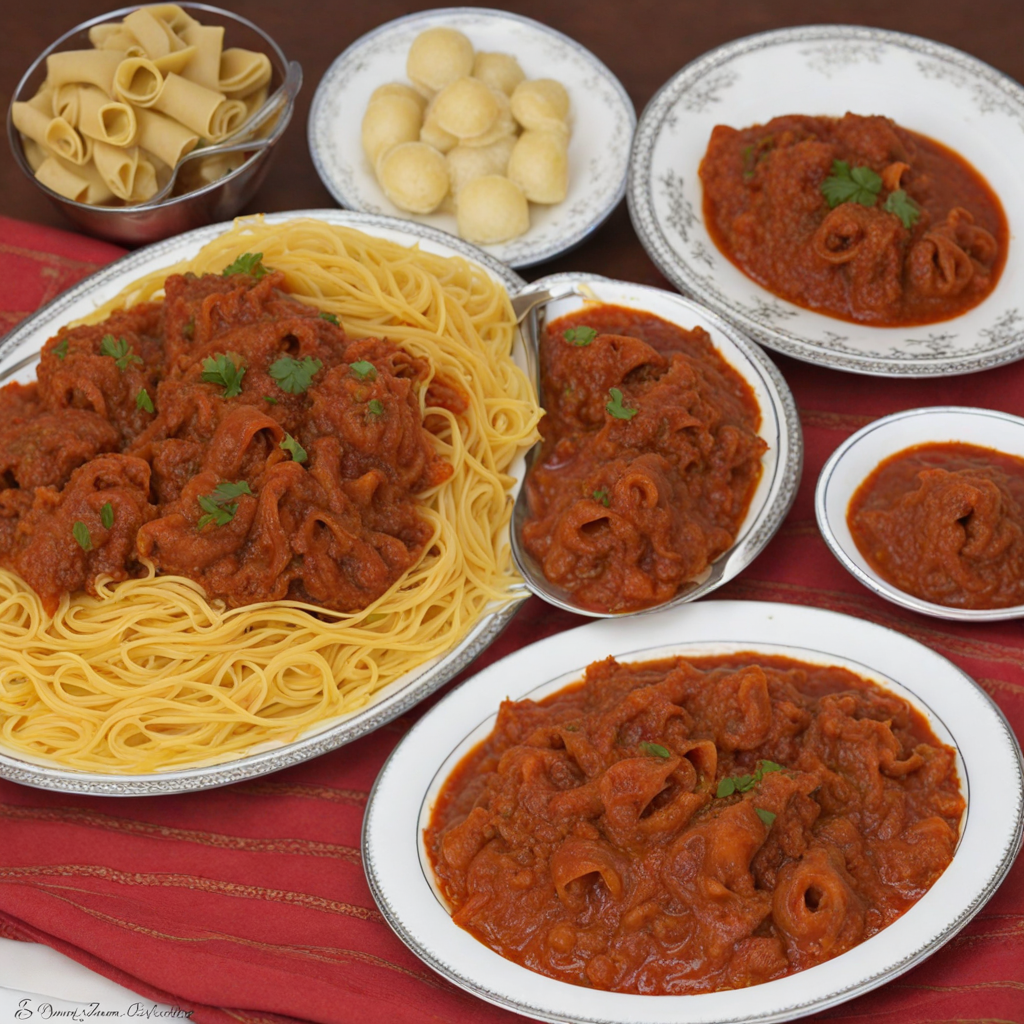Mbatten
Mbatten is a traditional Libyan dish that showcases the rich culinary heritage of the region. This hearty meal is primarily made from finely ground wheat or barley, which is then cooked to create a thick, creamy base. The grains are often combined with a variety of spices such as cumin, coriander, and paprika, giving the dish a warm, aromatic flavor profile that is both comforting and satisfying. The use of local ingredients, including fresh vegetables and robust meats, further enhances the depth of flavors, making Mbatten a true reflection of Libyan cuisine. One of the distinctive features of Mbatten is its versatility. It can be prepared as a vegetarian dish, featuring an abundance of seasonal vegetables like eggplant, zucchini, and bell peppers, or it can incorporate tender meats such as lamb or chicken. The combination of textures—from the creamy grain base to the succulent pieces of meat or crisp vegetables—creates a delightful contrast that excites the palate. Additionally, Mbatten is often served with a side of spicy harissa, a chili paste that adds an extra kick and elevates the overall taste experience. When enjoying Mbatten, it is common to share the dish with family and friends, reflecting the communal aspect of Libyan dining culture. The meal is typically accompanied by fresh, crusty bread, perfect for scooping up the rich, flavorful mixture. As you take a bite, the warmth of the spices mingles with the sweetness of the vegetables and the savory notes of the meat, offering a complex yet harmonious taste. Mbatten is not just a meal; it is an invitation to explore the vibrant culinary traditions of Libya and to savor the love and care that goes into each preparation.
How It Became This Dish
Origins of مبطن مبطن (Mabtoun or Mabton) is a traditional Libyan dish that showcases the rich culinary heritage of Libya, reflecting the country's geographical diversity and its historical interactions with various cultures. Its roots can be traced back to the Berber and Arab influences that have shaped Libyan cuisine over centuries. The dish is characterized by its use of semolina, which is a staple grain in North African cooking, and it often includes a variety of fillings that can range from meats to vegetables, depending on regional preferences and seasonal availability. Historically, مبطن was a dish prepared for special occasions and gatherings, embodying the spirit of hospitality that is central to Libyan culture. Families would come together to prepare large quantities of this dish, making it a communal activity that reinforced social bonds. The preparation of مبطن often includes a ritualistic aspect, where the act of cooking becomes a form of storytelling, with each family imparting its own unique traditions and techniques. Cultural Significance In Libya, food is more than sustenance; it is a means of expressing identity and cultural heritage. مبطن holds a significant place in the Libyan culinary landscape, often served during festive occasions such as weddings, religious celebrations, and family gatherings. Its preparation is not merely about feeding a crowd; it is an art form, showcasing the cook's skills and the family's culinary lineage. The dish's cultural significance extends beyond the kitchen. It serves as a symbol of unity and togetherness, often bringing families and communities together. During the preparation of مبطن, stories are shared, and memories are made, reinforcing connections among generations. This communal aspect of cooking and sharing meals is a vital part of Libyan culture, emphasizing the importance of family and social ties. Ingredients and Preparation The primary ingredient in مبطن is semolina, which is used to create a dough that serves as the vessel for the filling. The filling can vary widely, with options including spiced ground meat (often lamb or beef), vegetables, and sometimes even legumes. The spices used in the dish reflect the rich flavors of North African cuisine, with cumin, coriander, and paprika being common choices. The preparation involves several steps: first, the semolina is mixed with water and kneaded into a dough. Once the dough is ready, it is rolled out and shaped into a thin layer. The filling is then placed on top, and the dough is folded over to encase the mixture, forming a flat, stuffed bread. This bread can be baked or steamed, depending on the regional variations and personal preferences. The final product is a fragrant and flavorful dish that is often served with a side of salad or dips. Regional Variations As with many traditional dishes, regional variations of مبطن exist across Libya, each reflecting local ingredients and culinary practices. In coastal areas, for instance, seafood may be incorporated into the filling, while in the interior, one might find more meat-based options. Additionally, spices and herbs can differ based on the region, showcasing the local palate and agricultural produce. In the city of Tripoli, the capital of Libya, مبطن is often made with a rich meat filling and served with a tangy tomato sauce, enhancing the flavors of the dish. Meanwhile, in the eastern regions, where Berber influences are more pronounced, the dish may take on a more rustic appearance, with a focus on hearty ingredients and robust flavors. These variations highlight the diversity of Libyan cuisine, where local customs and ingredients play a crucial role in shaping traditional dishes. Modern Adaptations In contemporary Libya, while traditional recipes for مبطن are still cherished, there is also a trend toward modern adaptations. Chefs and home cooks alike are experimenting with new flavors and techniques, introducing ingredients such as cheese, herbs, and even international spices. This evolution reflects a broader trend in Libyan cuisine, where globalization and culinary innovation are merging with age-old traditions. Social media has played a significant role in this modernization, allowing cooks to share their creations and inspire others. This digital platform has led to a revival of interest in traditional dishes, as younger generations seek to celebrate and reinterpret their culinary heritage. Today, you can find variations of مبطن in restaurants throughout Libya and beyond, often with a contemporary twist that retains the essence of this beloved dish. Conclusion: A Symbol of Resilience Throughout its history, مبطن has remained a beloved dish in Libyan culture, embodying the resilience and adaptability of the Libyan people. It serves as a reminder of the importance of food in fostering connections and preserving traditions. As Libya continues to navigate its complex social and political landscape, dishes like مبطن offer a sense of continuity and comfort, underscoring the role of food as a fundamental part of cultural identity. In a world that is increasingly fast-paced and globalized, the preparation and enjoyment of مبطن stand as a testament to the enduring power of culinary traditions. It invites both locals and visitors alike to not only savor its flavors but also to engage with the rich history and cultural significance that it represents. As families gather to prepare and share this dish, the legacy of مبطن lives on, celebrating the vibrant tapestry of Libyan cuisine.
You may like
Discover local flavors from Libya







